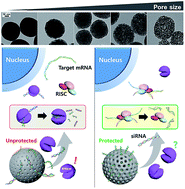In-depth study on the gene silencing capability of silica nanoparticles with different pore sizes: degree and duration of RNA interference†
Abstract
The mesoporous silica nanoparticle (MSN) has been utilized for various drug delivery systems. For the efficient loading and functional delivery of bioactive molecules, the pore size should be finely controlled. Here, we synthesize MSNs having different pore sizes and investigate the relationship between the pore size of the MSN and the efficacy and kinetics of gene silencing induced by siRNA loaded MSNs. We found that MSNs with various pore sizes present great differences in gene down-regulation of green fluorescence protein (GFP), vascular endothelial growth factor (VEGF) and hepatitis C virus non-structural protein 3 (HCV NS3) as well as the endocytosis pathways of MSNs in cancer cells. In specific, MSNs with a 7 and 10 nm pore size show the most significant gene knockdown with a long-lasting effect and great protective effect of the cargo from nuclease-mediated degradation compared to MSNs with a 2, 4 and 23 nm pore size. In addition, although similar amounts of siRNA was delivered inside cells, the degree of gene knockdown was significantly different depending on pore size of the employed MSN. The present study indicates that the porosity in nanoparticles acts as a crucial factor in a potent biomolecule cargo delivery system and the optimized MSN based system should provide better opportunities in the application of porous nanoparticles in biomedical research and clinical applications in the future.


 Please wait while we load your content...
Please wait while we load your content...